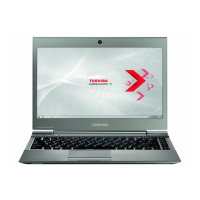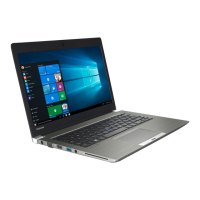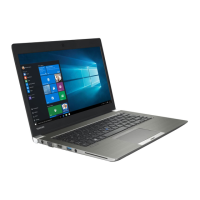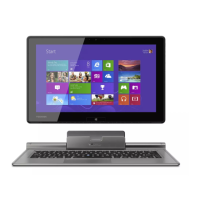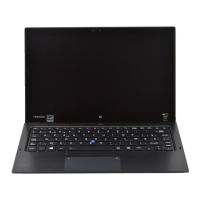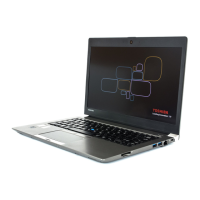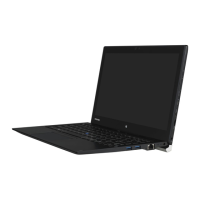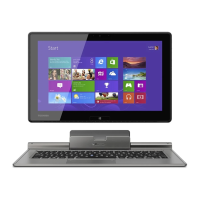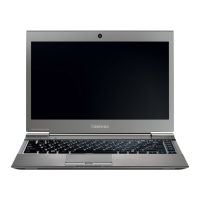
Do you have a question about the Toshiba PORTEGE Z930 and is the answer not in the manual?
| Graphics | Intel HD Graphics 4000 |
|---|---|
| Battery Life | Up to 8 hours |
| Wireless | Wi-Fi 802.11a/b/g/n, Bluetooth 4.0 |
| Storage | 128GB SSD |
| Display | 13.3-inch (1366x768) LED-backlit |
| Operating System | Windows 7 Professional |
| Weight | 1.12 kg |
| Ports | HDMI, VGA, Ethernet, SD card slot |
| Processor | Intel Core i5 or i7 |
Details the technical specifications and capabilities of the computer, including microprocessor and memory configurations.
Provides a visual representation of the computer's internal components and their interconnections.
Describes the external floppy disk drive and its specifications.
Explains the mSATA Solid State Drive option and its specifications.
Details the computer's keyboard layout and functionality.
Describes the TFT color display specifications, including resolution and colors.
Explains the functions and specifications of the computer's power supply system.
Covers the types of batteries, their specifications, and charging control.
Lists the specifications for the AC adapter used with the computer.
Introduces the chapter on diagnosing and resolving computer malfunctions.
Guides users through a systematic process to identify the cause of a problem.
Provides steps to diagnose and fix issues related to the computer's power supply.
Offers procedures for identifying and resolving problems with the system board.
Details troubleshooting steps for the USB Floppy Disk Drive.
Outlines procedures for troubleshooting the mSATA Solid State Drive.
Provides methods for diagnosing and resolving keyboard-related issues.
Explains how to troubleshoot problems with the computer's touch pad.
Offers steps to diagnose and resolve issues with the computer's display.
Guides users through troubleshooting the Local Area Network connection.
Provides steps to diagnose and resolve issues with wireless network connectivity.
Details procedures for troubleshooting audio-related problems.
Explains how to troubleshoot issues with the memory card slot.
Offers guidance for troubleshooting the fingerprint sensor functionality.
Provides steps to diagnose and resolve issues with the built-in web camera.
Details troubleshooting procedures for the 3G connectivity.
Outlines steps to diagnose and resolve problems with the HDMI output.
Explains how to use diagnostic test programs to check hardware functionality.
Details the process of starting and running diagnostic tests on the computer.
Guides users through configuring hardware settings, including DMI information.
Describes the heatrun test to check system stability under load.
Lists the names of subtests available within the diagnostic test programs.
Explains the system test, covering ROM checksum, fan control, and Geyserville.
Details the keyboard test procedure to verify key input and scan codes.
Describes tests for the display, including VRAM, gradation, and dot patterns.
Outlines the procedure for testing floppy disks and the FDD.
Explains how to perform tests on the computer's hard disk drive.
Details the test for verifying the accuracy of the system's real-time clock.
Describes the Numeric Data Processor test.
Explains the PC card slot expansion test.
Details tests for CD-ROM and DVD-ROM drives.
Lists error codes and their corresponding status names for diagnostic tests.
Provides detailed status information for hard disk test errors.
Describes a program that tests unique functions of the specific computer model.
Explains the function and operation of the FDD head cleaning utility.
Details the function for logging and storing error information from tests.
Describes a continuous test for unattended operation, executing multiple tests sequentially.
Covers utilities for formatting, copying, and dumping floppy disks.
Explains how to view and retrieve system configuration information.
Details how to check Atheros wireless LAN card type and antenna connection.
Guides setting up a test environment for Intel wireless LAN cards.
Describes performing wireless LAN transmission/reception tests on the DUT.
Explains how to perform tests on LAN, Modem, Bluetooth, and IEEE1394 interfaces.
Provides instructions for testing the computer's sound system.
Explains accessing and navigating the system setup utility.
Details how to operate the T&D programs included on the CD.
Explains the procedure for starting the TOSHIBA Test & Diagnostic program from a CD.
Covers the equipment configuration and starting procedures for Windows PE T&D.
Details the configuration and operation of the FreeDOS T&D test program.
Lists error codes displayed during tests and their meanings.
Explains the three tasks within T&D: Log Utilities, Running Test, and FD & HD Utilities.
Provides detailed explanations for various test functions like System Test and Memory Test.
Introduces the chapter on FRU removal and replacement procedures.
Details the procedure for removing and installing bridge media and SIM cards.
Provides step-by-step instructions for removing and installing the battery pack.
Explains the procedure for removing and installing the memory module.
Details the steps for removing and installing the Solid State Drive (SSD).
Covers the removal and installation of the RTC battery, LN board, and 3G card.
Explains the procedure for removing and installing the DC fan.
Details the procedure for removing and installing the fin.
Outlines the process for removing and installing the system board and wireless LAN card.
Provides instructions for removing and installing the computer's speakers.
Details the procedure for removing and installing the touch pad and fingerprint sensor board.
Explains the steps for removing and installing the computer's keyboard.
Covers the procedure for removing and installing the cover and LCD assembly.
Provides detailed steps for removing and installing the LCD module.
Details the procedure for removing and installing wireless LAN, 3G antennas, and camera module.
Explains the procedure for removing and installing the display hinges.
Provides precautions and guidelines for safely handling the LCD module.
Shows the layout and component placement of various circuit boards.
Lists the pin assignments for various connectors on the system board and other components.
Provides tables of keyboard scan codes and character codes for different modes.
Illustrates the key layouts for UK and US keyboards.
Shows loopback connector wiring diagrams for RGB monitor and LAN.
Explains the process for rewriting the system BIOS program.
Details the procedure for rewriting the EC/KBC system program.
Presents the MTBF (Mean Time Between Failures) for the Z930 model.
